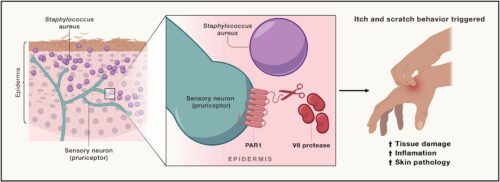
Staphylococcus scratches its itch
Jack Major, Shruti Naik
Itch exacerbates infection and inflammation-associated skin pathology. In this issue of Cell, Deng et al. identify a V8 protease released by Staphylococcus aureus triggering itch via neuronal protease-activated receptor 1. In so doing, they uncover profound consequences of microbial neurosensory modulation and the ensuing scratch-induced tissue damage that potentiates infection.
Cell
April 10, 2024
Cis-regulatory arbitrators of regeneration
Piotr Konieczny, Shruti Naik
Mammals favor healing with scaring over functional tissue regeneration.1 In this issue of Cell Stem Cell, Mack et al. use “super-healer” mice to identify cis-regulatory variations that direct regenerative versus fibrotic gene expression in wound fibroblasts and they uncover complement factor H as a molecular driver of skin regeneration.
Cell Stem Cell
September 06, 2023
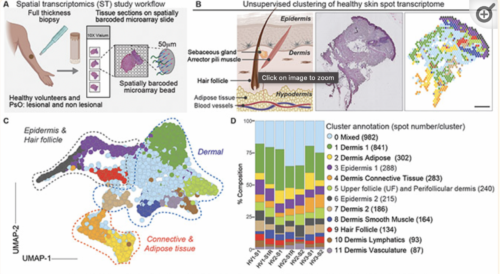
Spatial transcriptomics stratifies psoriatic disease severity by emergent cellular ecosystems
Rochelle L Castillo, Ikjot Sidhu, Igor Dolgalev, Tinyi Chu, Aleksandr Prystupa, Ipsita Subudhi, Di Yan, Piotr Konieczny, Brandon Hsieh, Rebecca H Haberman, Shanmugapriya Selvaraj, Tomoe Shiomi, Rhina Medina, Parvathy Vasudevanpillai Girija, Adriana Heguy, Cynthia A Loomis, Luis Chiriboga, Christopher Ritchlin, Maria De La Luz Garcia-Hernandez, John Carucci, Shane A Meehan, Andrea L Neimann, Johann E Gudjonsson, Jose U Scher, Shruti Naik
Whereas the cellular and molecular features of human inflammatory skin diseases are well characterized, their tissue context and systemic impact remain poorly understood. We thus profiled human psoriasis (PsO) as a prototypic immune-mediated condition with a high predilection for extracutaneous involvement. Spatial transcriptomics (ST) analyses of 25 healthy, active lesion, and clinically uninvolved skin biopsies […]
Science Immunology
June 02, 2023
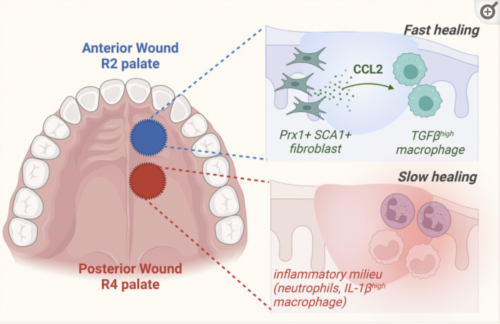
Fast and scarless: Prx1+ fibroblasts turbocharge healing
Rachel M Kratofil, Shruti Naik
Our oral cavity has evolved a capacity for rapid healing without scarring. In this issue of JEM, Ko et al. (2022. J. Exp. Med.https://doi.org/10.1084/jem.20221350) identify a Prx1+ fibroblast progenitor that drives oral regeneration by summoning pro-healing TGFβ1+ macrophages.
Journal of Experimental Medicine
March 06, 2023
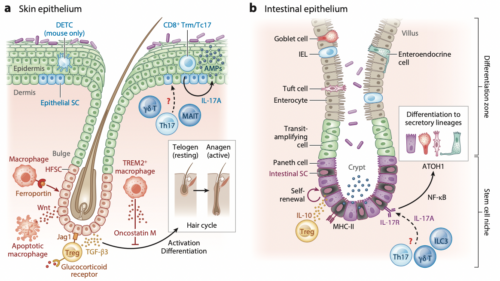
Immune-Epithelial Cross Talk in Regeneration and Repair
Laure Guenin-Mace, Piotr Konieczny, Shruti Naik
The epithelial tissues that line our body, such as the skin and gut, have remarkable regenerative prowess and continually renew throughout our lifetimes. Owing to their barrier function, these tissues have also evolved sophisticated repair mechanisms to swiftly heal and limit the penetration of harmful agents following injury. Researchers now appreciate that epithelial regeneration and […]
Annual Review of Immunology
January 25, 2023
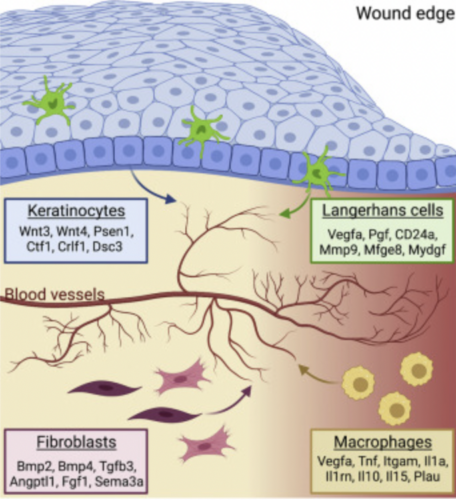
Langerhans cells are essential components of the angiogenic niche during murine skin repair
Renee Wasko, Kate Bridges, Rebecca Pannone, Ikjot Sidhu, Yue Xing, Shruti Naik, Kathryn Miller-Jensen, Valerie Horsley
Angiogenesis, the growth of new blood vessels from pre-existing vessels, occurs during development, injury repair, and tumorigenesis to deliver oxygen, immune cells, and nutrients to tissues. Defects in angiogenesis occur in cardiovascular and inflammatory diseases, and chronic, non-healing wounds, yet treatment options are limited. Here, we provide a map of the early angiogenic niche by […]
Developmental Cell
December 19, 2022
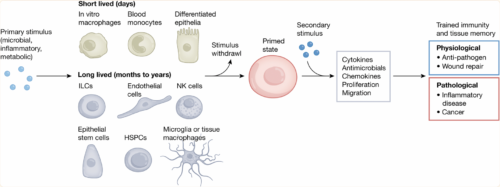
Inflammatory memory and tissue adaptation in sickness and in health
Shruti Naik, Elaine Fuchs
Our body has a remarkable ability to remember its past encounters with allergens, pathogens, wounds and irritants, and to react more quickly to the next experience. This accentuated sensitivity also helps us to cope with new threats. Despite maintaining a state of readiness and broadened resistance to subsequent pathogens, memories can also be maladaptive, leading […]
Nature
July 13, 2022
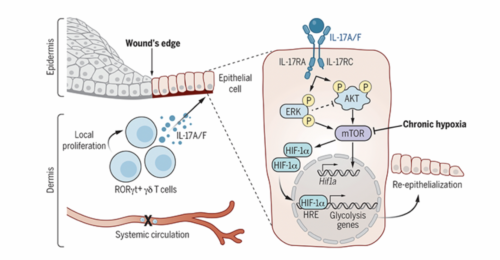
Interleukin-17 governs hypoxic adaptation of injured epithelium
Piotr Konieczny, Yue Xing, Ikjot Sidhu, Ipsita Subudhi, Kody P. Mansfield, Brandon Hsieh, Douglas E. Biancur, Samantha B. Larsen, Michael Cammer, Dongqing Li, Ning Xu Landén, Cynthia Loomis, Adriana Heguy, Anastasia N. Tikhonova, Aristotelis Tsirigos, and Shruti Naik
Mammalian cells autonomously activate hypoxia-inducible transcription factors (HIFs) to ensure survival in low-oxygen environments. We report here that injury-induced hypoxia is insufficient to trigger HIF1α in damaged epithelium. Instead, multimodal single-cell and spatial transcriptomics analyses and functional studies reveal that retinoic acid-related orphan receptor γt+ (RORγt+) γδ T cell-derived interleukin-17A (IL-17A) is necessary and sufficient to […]
Science Journal
July 08, 2022
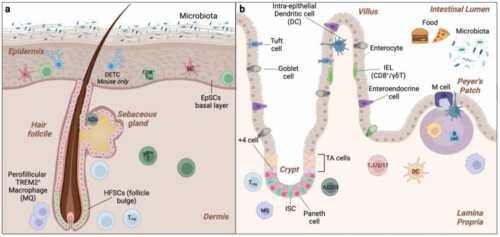
Epithelial-immune crosstalk in health and disease
Daniel Rosenblum, Shruti Naik
Far from inert structures, our body’s epithelial boundaries engage in a dynamic crosstalk with immune cells that is vital for immune surveillance and barrier function. Using the skin and gut epithelium, two structurally distinct but critical environmental interfaces, here we review the context-dependent interactions between myriad immune cells and epithelial subsets. We discuss immune communique […]
April 20, 2022
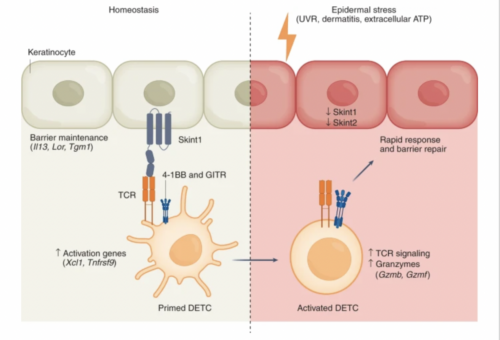
γδ T cells monitor tissue health
Ipsita Subudhi, Shruti Naik
Crosstalk between the dendritic epidermal γδ T cell (DETC) T cell receptor and Skint1 expressed by keratinocytes at steady state regulates epidermal barrier function and maintains DETC responsiveness.
Nature Immunology
February 14, 2022
|
Topic |
|---|
|
|
|
|
|
|
|
|
|
|
|
|
|
|
|
|
|---|